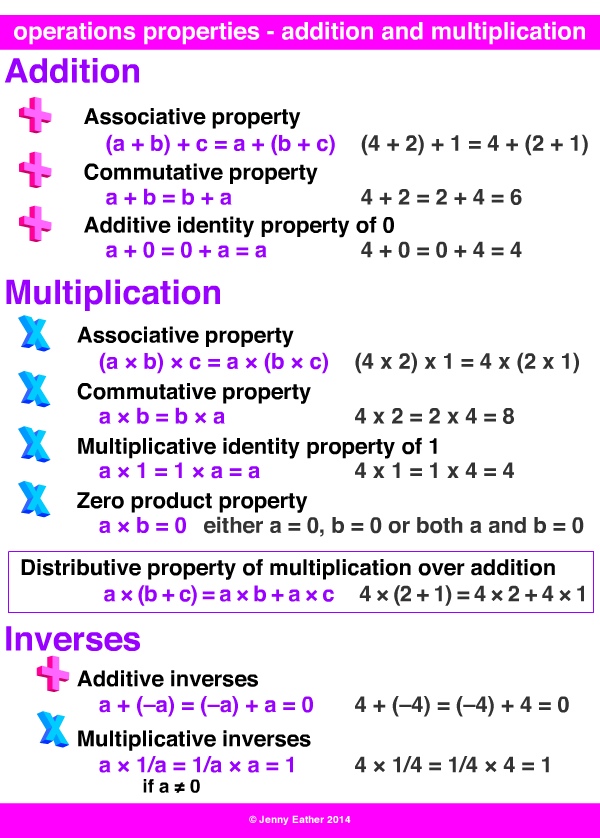operations properties
• a series of properties, rules or laws associated with
mathematical operations and equality.
EXAMPLES:
An identity is a special number that will not change
the value of the other number in an operation.
Zero is the additive identity,
a + 0 = a = 0 + a.
One is the multiplicative identity,
1 x a = a = a x 1.
An operation is associative if you can group the
numbers in any way without changing the answer.
Addition is associative,
a + (b + c) = (a + b) + c.
Multiplication is associative,
a x (b x c) = (a x b) x c.
Subtraction and division are not associative.
An operation is commutative if you can put the numbers
in any order without changing the answer.
Addition is commutative,
a + b = b + a.
Multiplication is commutative,
a x b = b x a.
Subtraction and division are not commutative.
Multiplying a number is the same as multiplying its addends
by the number, then adding the products.
Where b = c + d, a x b = (a x c) + (a x d)
e.g. 2 x 5 = (2 x 3) + (2 x 2).
Multiplication is distributive over
addition and subtraction.
The additive inverse of a number is the number
added to it to give the additive identity of 0,
a + (–a) = (–a) + a = 0
e.g. 2 and -2, 2 + (-2) = 0.
The multiplicative inverse of a number is the number it is
multiplied by to give the multiplicative identity of 1,
a × 1/a = 1/a × a = 1
e.g. 2 and 1/2, 1/2 x 2 = 1.
If the product of two or more numbers is zero, then
one or more of those numbers must also be zero
If ab = 0 either a = 0 or b = 0 or both a and b = 0.
Reflexive property of equality
a = a
Symmetric property of equality
If a = b, then b = a.
Transitive property of equality
If a = b and b = c, then a = c.
Addition property of equality
If a = b, then a + c = b + c.
Subtraction property of equality
If a = b, then a – c = b – c.
Multiplication property of equality
If a = b, then a × c = b × c.
Division property of equality
If a = b and c ≠ 0, then a ÷ c = b ÷ c.
Substitution property of equality
If a = b, then b may be substituted for a
in any expression containing a.
Exactly one of the following is true:
a < b, a = b, a > b.
If a > b and b > c then a > c.
If a > b, then b < a.
If a > b, then –a < –b.
If a > b, then a ± c > b ± c.
If a > b and c > 0, then a × c > b × c.
If a > b and c < 0, then a × c < b × c.
If a > b and c > 0, then a ÷ c > b ÷ c.
If a > b and c < 0, then a ÷ c < b ÷ c.
FURTHER EXAMPLES:

|
